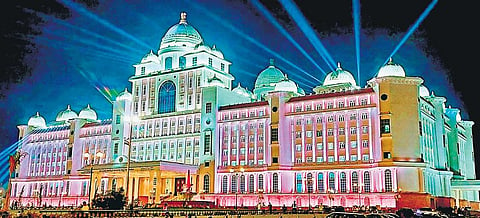

CHENNAI: The new secretariat of Telangana has been making news for its architectural glory. When the State wanted to reconstruct the house of policy-making, chief minister K Chandrashekar Rao’s demand was to select a design that reflects the aspirations of the people of Telangana. Several designs were submitted for approval. Finally, after the intervention of a committee of 500 experts, the design of Ponni M Concessao of Oscar & Ponni Architects was selected. The Chennai-based architect became the first female architect in the country to design a State secretariat. Walking us through her experiences of being a part of the Rs 617 crore project, the architect gives a deeper insight into her creation.
Reflecting history
The chief minister had instructed the architect that the building should last a minimum of 150 years without any problems. Ponni says, “We felt that there is a need for a mental connection between the building and the people. The aim was to create architecture that people were familiar with and are proud of as it more or less reflects people’s dreams.” By keeping those basic principles in mind, the team of almost 40 architects each in Chennai and Hyderabad began their research. “We learned about the history of Telangana. Rulers of ancient India, the Kakatiya kings that ruled Hyderabad, the invaders from the Middle East and Europe, leaders of modern India — they all brought in their style of architecture. With contextual architecture that reflects the architectural history or the architectural past of that place, we created something called Fusion Architecture,” she explains.
The team also followed ‘Green Architecture’, to bring in a lot of natural light and natural ventilation. Ponni claims, “We COVID-proofed the building by using cutting-edge technology. We used local products, including Nippon Paint which are anti-bacterial and reduced the carbon footprint.” All the furniture and building material came from Hyderabad except the sandstone which came from Rajasthan.
Highlights of the building
Delving deep into the highlights, she says, “The plan of the secretariat is rectangular. It has got four major cardinal gateways, 34 domes and a huge courtyard of two and a half acres in the centre. There is a colonnaded corridor, which is about 12 feet wide, that runs around inside of the building. The building height is about 265 ft. There is a circular sky launch where you can see the entire city of Hyderabad. We built a 10 lakh sq ft building in two years.”
The building has been named after Dr BR Ambedkar. While designing the building, Ponni and her team also managed to stick to Ambedkar’s ideology of social and gender equity. She says, “The building is secular. It has got a temple, a mosque and a church. We also have a creche where working mothers can drop off their children and pick them up at the end of the day. It is also created to ensure that in a few years, we will have 50% of women working there. The chief minister, who is also an engineer, understood the infrastructure very well. Through the social nuances of the contextual architecture together we were able to guarantee social and gender equity.”
When secretariat buildings are usually only office spaces, the Telangana secretariat becomes the only one in the country where every minister gets a conference room, a huge office space where they can work around the clock and a space for themselves. Even though adhering to the vision of the leaders wasn’t difficult, Ponni affirms that time was a constraint. She says, “The limited time of two years and the cost escalation because of the pandemic became a problem. But, we managed to do everything.”
Even though Ponni created history through her architectural achievements, this isn’t new for her. “When I was studying in NIT Trichy, I was the only woman among 3,000 men to study there. So being the first woman is not a new thing for me. But, when I look back at the journey of being the only woman at certain places, I understand how strong it made me,” she points out.
Ponni concurs that the construction industry is a male-dominated one where there is a myth that female architects usually opt for interior designing. She broke this notion too. “My team of architects from Chennai were mostly women. They efficiently worked during the pandemic without any problem. I believe that women are the best decision-makers. And I want a lot of women to be in politics and take up the highest positions available,” she signs off.